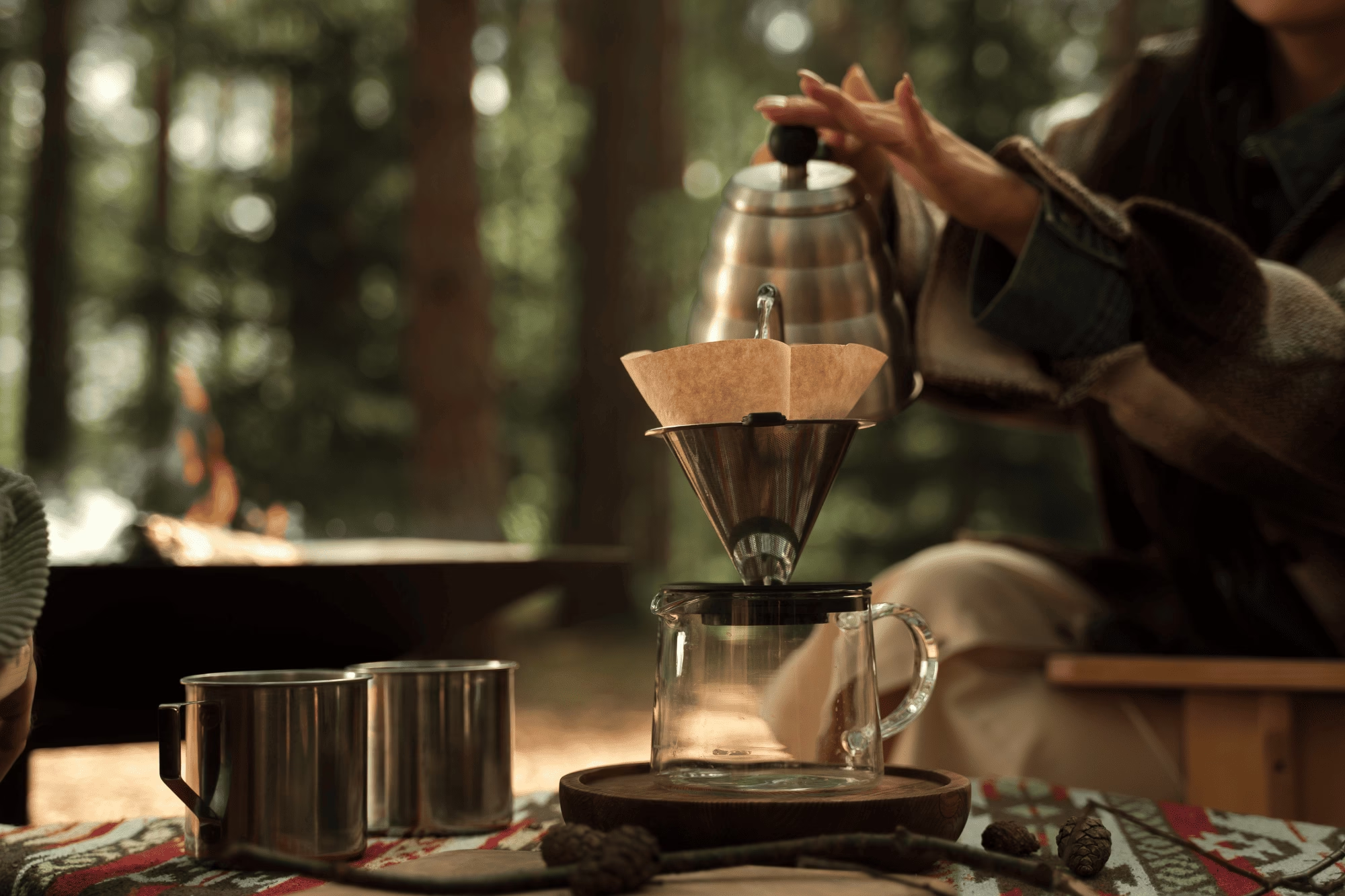Pour-over brewing offers an accessible entry point into specialty coffee, giving you control over every aspect of the brew. The good news? You don’t need barista-level expertise, if you beginners and no experience about pour-over brewing you just need to choose the right pour over coffee filter and a few simple techniques.
In this guide, I’ll walk you through everything you need to know about choosing the best pour-over coffee filter for beginners with absolutely no experience. Whether you’re looking to elevate your morning routine or simply curious about manual brewing methods, I’ve got you covered.
Pour-over coffee is a manual brewing method where hot water is poured over ground coffee beans contained in a filter. The water drains through the grounds and filter, directly into your cup or carafe below. Simple in concept, but the devil (and the delight) is in the details.
Table of Contents
Types of Pour-Over Coffee Filters
Pour-over filters generally fall into two main categories:
- Paper Filters: Single-use, disposable filters made from paper
- Permanent Filters: Reusable filters typically made from metal, cloth, or plastic
Each type has its pros and cons, especially for beginners. Paper filters are straightforward and create a clean cup but generate waste. Permanent filters are eco-friendly and cost effective in the long run but require cleaning and maintenance.
What is the Best Pour-Over Coffee Filter for Beginners with No Experience?
For absolute beginners with zero experience, I recommend starting with the Hario V60 Size 02 Paper Filters. Here’s why:
The Hario V60 system combines simplicity with excellent results, making it perfect for those just dipping their toes into pour-over brewing. The cone-shaped design and spiral ribs allow for consistent extraction, while the paper filters remove oils and sediment for a clean cup.
The V60’s distinctive large hole at the bottom might seem intimidating, but it actually simplifies the process by allowing gravity to do most of the work. You control the flow rate primarily through your grind size rather than complicated pouring techniques. The V60 is forgiving enough for beginners while having enough depth for you to grow into as your skills develop.
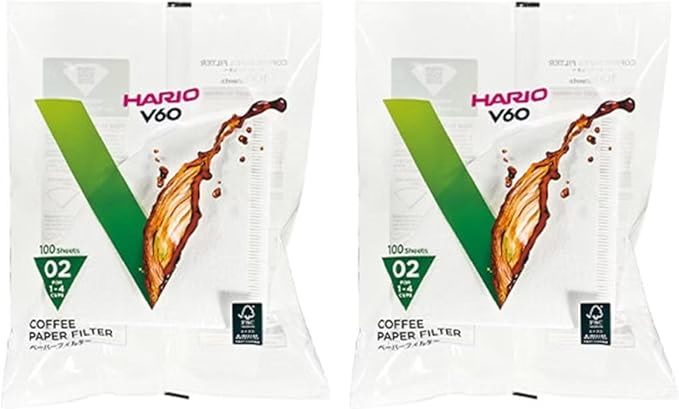
How Do I Choose a Pour-Over Coffee Filter as a Beginner?
Choosing your first pour-over filter doesn’t have to be complicated. Here are the factors I consider most important for beginners:
Ease of Use
As a novice brewer, you want something that won’t require a PhD in fluid dynamics to operate. Look for filters with:
- Simple designs
- Clear instructions
- Minimal required accessories
- Forgiving brew parameters
Consistency
Consistency is crucial when you’re learning. Some filters naturally promote even extraction, which means you’ll get a similar result each time, even as you’re figuring things out.
Cost
Start with something affordable. Pour-over brewing is a journey, and you might want to experiment with different methods as you gain experience.
Size
For beginners, I recommend a filter that makes 1-2 cups at a time. This allows for quick experimentation without wasting too much coffee.
Material
Paper filters are generally the easiest starting point, but if environmental concerns are top of mind, consider a stainless steel option.
Are Paper or Metal Filters Better for Beginner Pour-Over Coffee Brewing?
This is one of the most common questions I hear from pour-over newbies, and the answer depends on what you’re looking for in your coffee experience.
Paper Filters: The Beginner’s Friend
Pros:
- Create a cleaner, brighter cup with less sediment
- Remove oils that can make coffee taste heavy
- Simple to use with no cleaning required
- More forgiving of grind size variations
- Produce consistent results
Cons:
- Create ongoing waste
- Add recurring cost
- Can impart a slight paper taste (though rinsing before use helps)
Metal Filters: The Sustainable Option
Pros:
- Environmentally friendly and cost-effective long-term
- Allow natural oils to pass through, creating a more full-bodied cup
- Highlight different flavor notes in your coffee
- No paper taste whatsoever
Cons:
- Require cleaning after each use
- Allow fine sediment to pass through
- Less forgiving of incorrect grind size
- May be more difficult to master initially
For absolute beginners with no experience, I recommend starting with paper filters. They provide a more consistent experience while you’re learning the basics of pour-over brewing. Paper filters remove most of the oils and micro-sediment, resulting in a cleaner cup that many beginners find more approachable.
Once you’ve mastered the basics, you can explore metal filters to discover new dimensions in your coffee.
What is the Easiest Pour-Over Coffee Filter to Use for First-Timers?
If ease of use is your top priority (and for most beginners, it should be), here are my top recommendations:
1. Kalita Wave
The Kalita Wave features a flat bottom with three small holes, which naturally slows down water flow and promotes even extraction without requiring perfect technique. This makes it perhaps the most forgiving pour-over device for beginners.
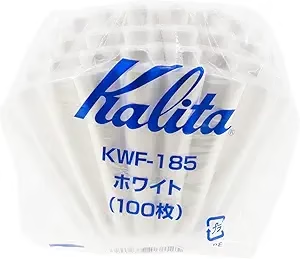
The wave-shaped filters create a gap between the brewing bed and the dripper walls, ensuring consistent temperature throughout the brew. As noted by Smiling Coffee Snob, “The Kalita Wave’s flat-bed design makes it much more forgiving for beginners who haven’t mastered their pouring technique yet.”
2. Melitta Pour-Over
The Melitta Pour-Over is perhaps the most accessible entry point into manual brewing. With its single hole design and wedge-shaped cone, it naturally regulates flow rate and is widely available at most grocery stores.
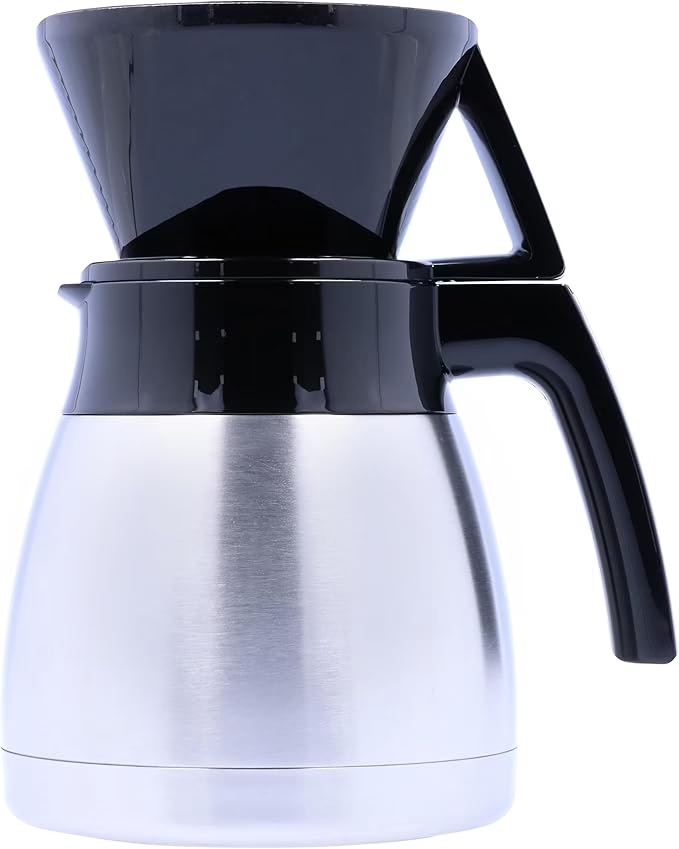
Its familiar shape and use of standard #2 or #4 filters make it approachable for coffee newcomers. I particularly like recommending this to friends who are curious about pour-over but aren’t ready to invest in specialty equipment.
3. Clever Dripper
While technically an immersion brewer with a pour-over element, the Clever Dripper deserves mention for absolute beginners. It features a valve that holds your coffee and water together until you’re ready to release it, combining the simplicity of a French press with the clean cup of a pour-over.
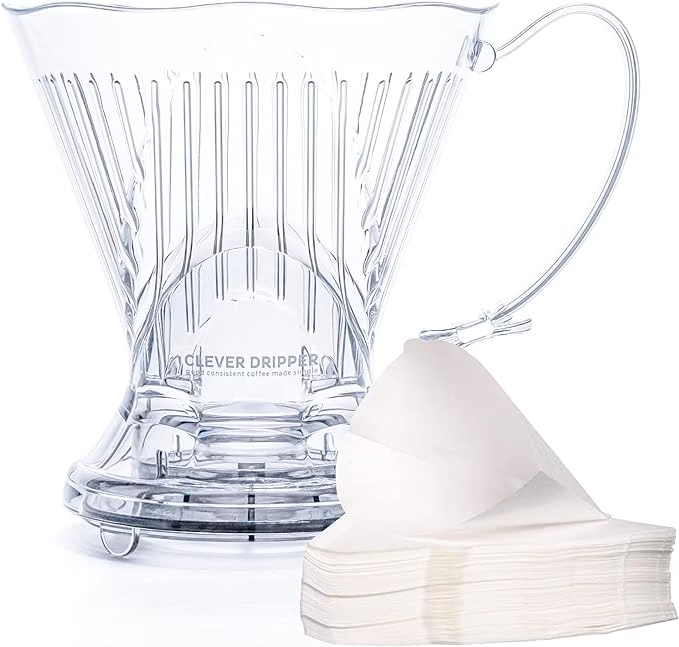
This hybrid approach makes it nearly foolproof and ideal for those still developing their technique.
Do I Need a Special Filter for Pour-Over Coffee as a Beginner?
You do need filters designed specifically for pour-over brewing, but they don’t need to be fancy or expensive.
Pour-over filters are designed with:
- Appropriate thickness to control flow rate
- Material suitable for hot water filtration
- Shapes that complement specific drippers
While you can technically use a regular flat-bottom coffee filter in some pour-over setups, you’ll get much better results with filters designed for the job. For instance, using a standard basket filter in a V60 would collapse the sides and create channeling issues that affect extraction.
For beginners, I recommend sticking with the filters designed for your specific dripper:
- Hario V60: Use V60 paper filters
- Kalita Wave: Use Wave filters with the distinctive wavy pattern
- Chemex: Use the thicker Chemex filters
- Melitta: Standard Melitta #2 or #4 filters work perfectly
As you gain experience, you might explore third-party filters or even reusable options, but when starting out, original manufacturer filters provide the most consistent experience.
How Does the Type of Coffee Filter Affect the Taste of Pour-Over Coffee?
The filter you choose can dramatically affect your coffee’s taste profile—something many beginners don’t realize until they experiment.
Paper Filters
Paper filters trap oils and fine particles, resulting in:
- Cleaner, brighter flavor notes
- More pronounced acidity
- Less body and mouthfeel
- Greater clarity in distinguishing specific flavor notes
Paper filters trap the oils that carry certain flavor compounds and remove most sediment, creating a ‘cleaner’ cup that highlights the brighter, more delicate notes in coffee.
Metal Filters
Metal allows oils and some fine particles to pass through, creating:
- Fuller body and mouthfeel
- More pronounced sweetness
- Muted acidity
- Richer overall experience with less distinct flavor separation
Filter Thickness
The thickness of paper filters also matters:
- Thicker filters (like Chemex): Maximum clarity, slower flow rate
- Medium filters (like V60): Balanced extraction, moderate flow rate
- Thinner filters (like Melitta): Faster flow, more body
For beginners just developing their palate, standard medium-thickness paper filters offer a good middle ground that lets you experience the range of flavors in your coffee.
What Grind Size Works Best with a Pour-Over Coffee Filter for Beginners?
Grind size is crucial for successful pour-over brewing, but as a beginner, it can seem confusing. Here’s a simple approach:
For most pour-over methods, aim for a medium-fine grind—something similar to table salt in consistency. This provides a good starting point that works reasonably well across different pour-over systems.
Here’s a more specific breakdown by brewer type:
| Pour-Over Device | Recommended Grind Size | Visual Comparison |
|---|---|---|
| Hario V60 | Medium-fine | Table salt |
| Kalita Wave | Medium | Beach sand |
| Chemex | Medium-coarse | Kosher salt |
| Melitta | Medium | Beach sand |
| Clever Dripper | Medium-coarse | Kosher salt |
I will points out, “The grind size affects how quickly water flows through your coffee. Too fine, and you’ll get bitter, over-extracted coffee. Too coarse, and you’ll get sour, under-extracted coffee.”
If you don’t have a grinder at home, most coffee shops can grind beans to your specifications—just tell them you’re brewing with a pour-over method and they’ll know what to do.
How Often Should I Replace or Clean My Pour-Over Coffee Filter?
Maintenance depends entirely on the type of filter you’re using:
Paper Filters
Paper filters are single-use and should be disposed of after each brew. Some environmentally-conscious brewers compost their used filters and coffee grounds.
Metal Filters
Stainless steel filters should be:
- Rinsed thoroughly after each use
- Deep cleaned weekly by soaking in a solution of water and a small amount of dish soap
- Periodically descaled with a vinegar solution if you notice buildup
Cloth Filters
Cloth filters require more maintenance:
- Rinse thoroughly after each use
- Store in water in the refrigerator between uses
- Boil once a week to remove coffee oils
- Replace every 2-3 months depending on use
For beginners, paper filters eliminate the cleaning hassle, allowing you to focus on perfecting your brewing technique. As Bonavita suggests, “Starting with paper filters lets you focus on variables like water temperature and pouring technique without the added variable of filter maintenance.”
Can I Use a Regular Coffee Filter for Pour-Over Brewing?
In a pinch, you can use regular basket-style coffee filters for some pour-over methods, but there are important limitations to consider.
Standard flat-bottom filters designed for drip coffee makers can work with:
- Melitta-style cone drippers (with some folding)
- Kalita-style flat bottom drippers (with careful placement)
However, they won’t work well with:
- Hario V60 (shape mismatch)
- Chemex (flow rate issues)
The problem with substituting filters is that each pour-over system is designed with a specific filter shape, thickness, and material in mind. Changing these variables affects:
- Flow rate
- Extraction pattern
- Temperature stability
- Overall consistency
If you’re just starting out, I strongly recommend using the correct filters for your chosen brewing method. This eliminates one potential source of inconsistency while you’re learning.
What Are Some Beginner Mistakes to Avoid When Using a Pour-Over Coffee Filter?
Even with the right equipment, beginners often encounter some common pitfalls. Here are the mistakes I see most frequently:
1. Not Pre-Wetting the Filter
Skipping this step can lead to a papery taste in your coffee. Always rinse your paper filter with hot water before brewing. This:
- Removes paper taste
- Preheats your brewing vessel
- Helps seal the filter to the dripper
2. Using Water That’s Too Hot
Boiling water can scorch your coffee grounds. Let your water cool for about 30 seconds after boiling, aiming for 195-205°F (90-96°C). If you don’t have a thermometer, just wait briefly after your kettle boils.
3. Inconsistent Pouring Technique
Wild pouring can create channels in your coffee bed, leading to uneven extraction. Start slow, and consider a gooseneck kettle which offers better control.
4. Incorrect Grind Size
Too fine a grind leads to bitter, over-extracted coffee. Too coarse results in weak, sour coffee. Start with medium-fine and adjust based on taste.
5. Using Too Little Coffee
Under-dosing creates weak, unbalanced coffee. Start with a ratio of 1:16 (coffee to water) and adjust to taste. For a standard mug, that’s about 15g of coffee to 240ml of water.
As Minimalist Baker explains, “Most pour-over brewing issues come down to basic variables like water temperature, grind size, and coffee-to-water ratio. Get these right, and you’re 90% of the way to great coffee.”
Best Pour-Over Coffee Filter Options for Different Beginner Needs
Depending on your specific situation, different filters might serve you better. Here are my top recommendations for various beginner scenarios:
Best for Absolute Beginners: Melitta Pour-Over Cone with Melitta Filters
The Melitta system is affordable, widely available, and extremely straightforward. The single hole design naturally regulates flow rate, making it forgiving for those still learning pouring techniques.
Best for Eco-Conscious Beginners: Able Kone Filter for Chemex or V60
If sustainability is your priority, the Able Kone stainless steel filter eliminates paper waste while still being relatively beginner-friendly. Just be prepared for a different flavor profile and some additional cleaning.
Best for Budget-Conscious Beginners: Hario V60 Plastic Dripper with Paper Filters
The plastic V60 delivers excellent coffee at a fraction of the cost of ceramic or glass models. Paired with V60 paper filters, it’s an affordable entry into specialty coffee brewing.
Best All-Around Option: Kalita Wave 185 with Kalita Filters
The Wave’s flat-bottom design and three-hole drainage make it exceptionally forgiving for beginners while still producing excellent coffee. The wave-shaped filters maintain consistent temperature throughout brewing.
Most Gifted to New Coffee Enthusiasts: Chemex with Chemex Filters
The Chemex combines form and function beautifully, making it a popular gift choice. While requiring slightly more technique than other options, its iconic design and excellent results make it a joy to use and display.
As New York Times Wirecutter notes in their extensive testing, “The right pour-over setup is as much about personal preference as it is about objective quality. Finding the right match for your needs is key.”
Step-by-Step Guide to Using Your Pour-Over Filter for the First Time
Once you’ve chosen your filter, here’s how to get started:
- Prepare your equipment
- Rinse your paper filter with hot water
- Discard the rinse water
- Place your dripper on your mug or carafe
- Measure your coffee
- Use 15g of coffee (about 2-3 tablespoons) per 240ml cup
- Grind to medium-fine consistency
- Add coffee to filter
- Pour grounds into filter
- Gently shake to level the bed
- Heat your water
- Bring water to boil
- Let cool for 30 seconds (to approximately 200°F/93°C)
- Bloom the coffee
- Pour twice the weight of coffee in water (e.g., 30g water for 15g coffee)
- Start from the center and work outward in a spiral
- Let sit for 30-45 seconds
- Complete the brew
- Pour remaining water in slow, steady spirals
- Maintain a consistent water level above the grounds
- Total brew time should be 2:30-3:30 minutes
- Enjoy!
- Remove the dripper
- Discard or clean your filter
- Savor your freshly brewed coffee
By Following this basic process, will get you started with any pour-over system.
Conclusion
Pour-over coffee brewing offers a delightful entry point into the world of specialty coffee, and choosing the right filter is your first step on that journey. For beginners with no experience, I recommend starting with paper filters paired with a forgiving dripper like the Kalita Wave or Melitta Pour-Over.
Remember that learning to brew great pour-over coffee is a process—each cup is an opportunity to refine your technique. Don’t be discouraged by early missteps; even experienced baristas are constantly tweaking their approach.
The most important thing is to enjoy the process. There’s something meditative about the ritual of manual brewing that makes the resulting cup taste even better.
Ready to take the plunge? Pick up one of the beginner-friendly filters we’ve discussed, grab some freshly roasted beans, and discover the satisfaction of crafting your perfect cup.
What’s your experience with pour-over brewing? Have questions about getting started? Let me know in the comments below!

